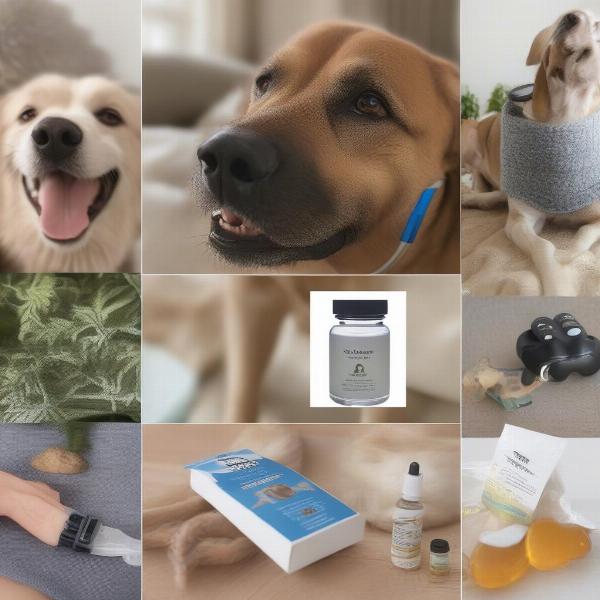Calmers for dogs can be a helpful tool for managing stress and anxiety in our canine companions. Whether it’s a thunderstorm, a trip to the vet, or separation anxiety, there are a variety of situations that can cause our dogs to feel uneasy. Understanding the different types of calming aids available, how they work, and choosing the right one for your dog is essential for ensuring their well-being. This article will explore the world of dog calmers, offering insights and advice to help you make informed decisions for your furry friend.
Understanding Dog Anxiety and Stress
Before exploring different calmers, it’s important to recognize the signs of stress and anxiety in dogs. These can manifest in various ways, including excessive barking, panting, pacing, destructive behavior, trembling, and changes in appetite. Identifying the underlying cause of the anxiety, such as noise phobias, separation anxiety, or travel-induced stress, is crucial for effective management. Addressing the root cause in conjunction with using calming aids often yields the best results.
Types of Calmers for Dogs
Several types of calmers are available for dogs, each working through different mechanisms:
- Pheromone Diffusers and Sprays: These mimic naturally occurring pheromones that mother dogs release to calm their puppies. Synthetic versions of these pheromones, like Adaptil, can help create a sense of security and comfort for dogs.
- Nutritional Supplements: Calming supplements often contain ingredients like L-theanine, chamomile, or melatonin, which have relaxing properties. These can be beneficial for managing general anxiety or situational stress.
- CBD Products: CBD oil and treats have gained popularity for their potential calming effects on dogs. It’s essential to choose high-quality CBD products specifically formulated for pets and consult with your veterinarian before using them.
- Prescription Medications: For severe anxiety cases, your veterinarian may prescribe medication. These are typically used when other calming methods haven’t been effective. It’s important to discuss the potential side effects and benefits with your vet.
- Calming Music and Sounds: Specifically designed music or soundscapes can help create a relaxing environment for dogs. These can be particularly helpful for noise-sensitive dogs.
- Pressure Wraps: Similar to swaddling a baby, pressure wraps like the Thundershirt can provide a comforting, gentle pressure that helps reduce anxiety.
 Different Types of Dog Calmers
Different Types of Dog Calmers
Choosing the Right Calmer for Your Dog
Selecting the appropriate calmer depends on your dog’s individual needs and the specific situation causing their anxiety. For mild anxiety or situational stress, pheromones, supplements, or calming music might be sufficient. For more severe anxiety, prescription medication might be necessary under veterinary guidance. It’s also important to consider your dog’s temperament, age, and overall health.
How to Use Calmers Effectively
Always follow the manufacturer’s instructions when using any calming product. Introduce calmers gradually to allow your dog to adjust. Combine calming aids with behavior modification techniques and environmental enrichment for optimal results. Consult with your veterinarian if you have any concerns or questions about using calmers for your dog.
Conclusion
Calmers for dogs can be valuable tools in helping our furry friends manage stress and anxiety. By understanding the different types available and choosing the right one for your dog’s specific needs, you can create a more peaceful and comfortable environment for them. Remember to consult with your veterinarian for guidance on the best approach for your dog’s individual situation.
FAQ
- Are dog calmers safe? Most calming aids are safe when used as directed. However, it’s always best to consult your veterinarian before introducing any new product to your dog’s routine.
- How long does it take for dog calmers to work? The onset of effects varies depending on the type of calmer used. Some, like pheromones, may take a few days to show noticeable results, while others, like prescription medication, may work more quickly.
- Can I use multiple calming methods together? In some cases, combining different calming methods can be beneficial. However, always consult with your veterinarian before combining products or techniques.
- What are some natural calming techniques for dogs? Exercise, mental stimulation, and creating a predictable routine can help naturally reduce anxiety in dogs.
- Are there any side effects associated with dog calmers? Some calmers may have potential side effects, such as drowsiness or digestive upset. Consult with your veterinarian about potential risks.
- What if my dog’s anxiety doesn’t improve with calmers? If your dog’s anxiety persists despite using calming aids, consult with your veterinarian or a certified dog behaviorist for further evaluation and guidance.
- Can I give my dog human calming supplements? Never give your dog human medications or supplements without consulting your veterinarian. Many human products are toxic to dogs.
About ILM Dog
ILM Dog is your trusted international resource for expert dog care and nurturing advice. We offer a wealth of information on dog breeds, health, training, nutrition, grooming, and much more, catering to both new and experienced dog owners worldwide. From choosing the right breed to understanding your dog’s health needs, ILM Dog is committed to providing comprehensive and practical guidance to ensure the well-being of your canine companion. For expert advice on your dog’s specific needs or to learn more about our services, contact us at [email protected] or +44 20-3965-8624. We’re passionate about helping you and your furry friend enjoy a happy and healthy life together.